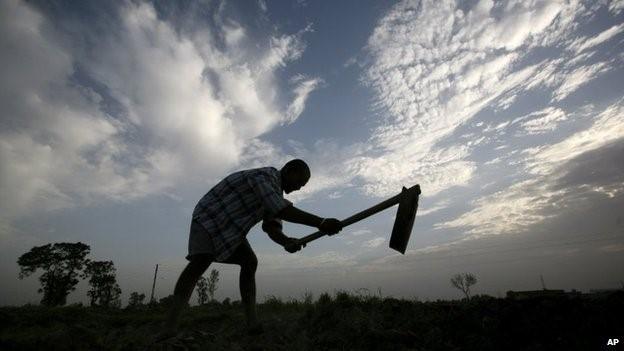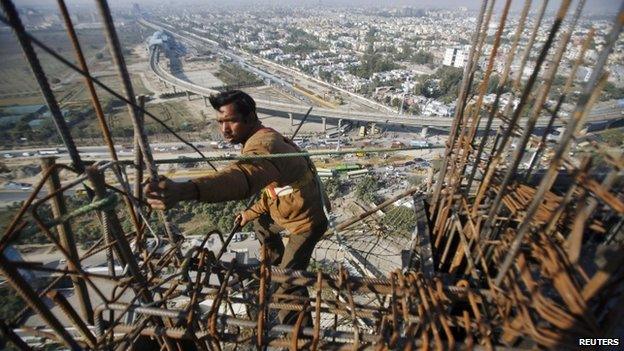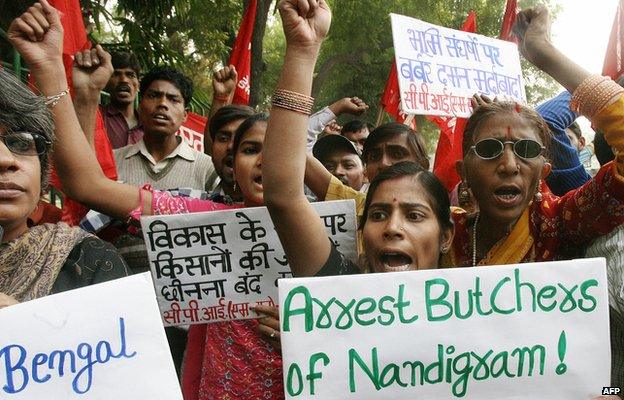Why is India facing growing conflict over land?
- Published

Critics say the new land acquisition rules will disadvantage farmers and the rural poor
A controversial bill on land acquisition has caused uproar in India, with opponents saying it will hurt the interests of farmers. The bill eases rules for acquiring land for specific projects. The government says it is aimed at kick-starting stalled projects across the country worth billions of dollars. Sanjoy Chakravorty, author of a book on conflicts over land in India, explains the issues.

Why is land so important in India?
Land is India's scarcest resource and the source of livelihood for over half its population.
The average size of land owned by a farmer was a mere three acres a decade ago; it's even less now.
In states like Kerala, Bihar, West Bengal, Uttar Pradesh and Tamil Nadu, the average holding is between half an acre and two acres.
To put this in context: the average landholding is 110 acres in France, 450 acres in the US, and even higher in Brazil and Argentina.
Farming is the least productive sector of the economy - agriculture accounts for 15% of India's GDP, while employing more than half of its workforce.
So India's scarcest resource is also its least productive. This is a very serious problem and a fundamental reason for India's poverty.

Why does India need to acquire land?
There are two basic ways to increase productivity.
One, make agriculture more efficient, and two, change land use from agriculture to something else. The development process of independent India followed exactly that prescription.

India needs land for housing and infrastructure
A large scale, state-led effort to irrigate and modernise agriculture was combined with a massive state-led drive to industrialise and urbanise. Both led to land acquisition on a very large scale.
The instrument used was a land acquisition law from 1894 that the government of independent India found convenient to deal with fragmentation of land holdings - with one blow it removed the twin problems of "holdouts" (or unwilling sellers) and unclear or disputed titles.

How much land has been acquired?
Since India's independence in 1947, it is estimated that more than 50 million acres of land - about 6% of India's total land - were acquired or converted, and more than 50 million people affected.
Most affected landowners were paid little. Many were never paid. Non-owners who were dependent on land for livelihoods were routinely not paid.
Very little resettlement or rehabilitation was done, and what was done was shoddy. Tribals and dalits (formerly known as untouchables) were the worst sufferers.
It was a severely unjust system that ruined millions of families and in the process produced modern India - its infrastructure, irrigation and energy systems, industrialisation, and urbanisation.

Why did protests against land acquisition begin?
Criticism of the way the government was acquiring land had been building from civil society groups from the 1980s.
Non-governmental group Narmada Bachao Andolan (Save the Narmada movement) became the spearhead of resistance to a controversial dam project , externaland a training ground for a generation of skilful organisers against forcible land acquisition.
The turning point came in 2006-7 with the setting up of tax-free special economic zones, external to attract foreign investment and violent resistance to government's plans to set up a chemical hub in Nandigram in West Bengal. , external

Farmers in Nandigram fiercely resisted the West Bengal government's plan to acquire land
There were other agitations against takeover of farmland for mines, factories, ports, townships and highways.
Many civil society groups argued that special economic zones were an official way for Indian businesses to grab farmland and protests against land acquisition became a nationwide phenomenon.

What does the Land Acquisition Law say?
The Right to Fair Compensation and Transparency in Land Acquisition, Rehabilitation and Resettlement Act, 2103 , external- was created to deal with widespread protests against land acquisition.
The law has five important elements:
Increased compensation for farmers - market prices are doubled in urban and quadrupled in rural areas
Expanded coverage of compensation - non-owners facing loss of livelihood are compensated
Rehabilitation and resettlement of people evicted from their lands was made compulsory
Taking informed consent of land-losers - using referendums, specifically when the acquisition has any private sector involvement; the consent of 70% of families is required where land is sought to be acquired for public-private partnership projects, and 80% for private projects
Social impact assessments to determine a project's impact on people's lands and livelihoods; more specifically, to identify all affected people
The first three elements contribute to the direct price of acquisition (which are also the direct benefits for those losing land - and livelihoods); the latter two elements contribute to the indirect price (transaction and opportunity costs).

What changes has the new government made to the law?
In December, the Narendra Modi-led BJP government passed an ordinance or an executive order removing the "informed consent" and "social impact assessment" requirements for a range of projects, including those relating to defence and national security, rural infrastructure, affordable housing, industrial corridors, and infrastructure.

Land prices vary massively across India
The new bill would reduce acquisition time for these projects by several years.
This would significantly reduce costs in a land market that is likely the most expensive in the world.

Is the opposition to the new bill justified?
Yes, considering the record of historic injustices, especially on marginalised groups in rural India.
But the opposition may not be justified considering that the price of land - especially plots close to urban areas - has skyrocketed and will yield windfall benefits for landowners in these locations.
Also, there is nothing in the bill which protects the most vulnerable populations like tribespeople from the machinations of land acquisition.
They are prey to a range of corrupt practices involving politically-connected insider information and local land mafias leading to the possibility of much-reduced payoffs and contrived consent.
There is not a homogenous Indian farmer, nor is there a single land market.
At one end, land prices are 25-100 times higher than the income possible from "farming till eternity"; at the other, prices are only two to four times higher.
What is needed is an acquisition law that recognises the geographical and economic diversity of India and its specific local land cultures and histories.
Sanjoy Chakravorty is author of The Price of Land: Acquisition, Conflict, Consequence
- Published14 September 2011